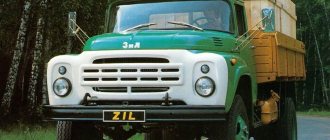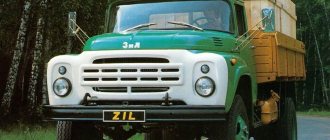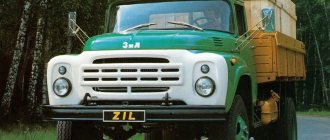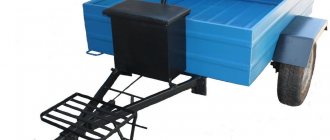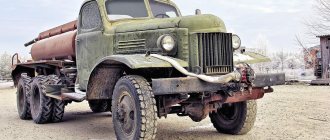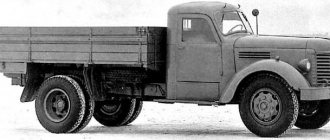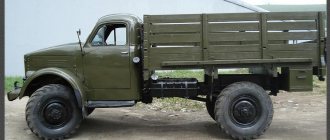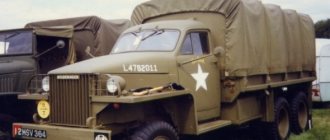We can talk about the legendary ZIL 130th model for hours. It all started in the post-war years, when the Soviet Union needed equipment for agricultural needs. This Soviet, and later Russian car, replaced the old ZIL-164 model, which was initially produced as the ZIS-150. Before the model became what we know it to be, quite a few changes were made to it. Before the restructuring of the Stalin plant, the model was produced as the ZIS-125.
As a product of the Likhachev plant, it was produced from 1962 to 2010. Initially, assembly was carried out in Moscow, but in the 90s the facilities were moved to Novouralsk. There the car was produced under a different name, Amur. It is noteworthy that the ZIL-130 became the first truck of its kind to be painted white and blue. Before this, all ZILs were painted khaki, since they were created for military purposes. The entire ZIL model range.
Appearance
The foreshadowing versions of ZIL trucks were extremely unfinished and crude. The justification is compelling; a large amount of equipment was required to repair damage after the war. But in the end, already in 1956, prototypes were significantly more beautiful than their predecessors.
After a number of regular changes, which concerned both the restyling of the truck and the plant itself, the ZIL-130 was presented at the annual international fair in Leipzig, where it received a gold medal, and the engineers received many diplomas. Since that time, the “130” model began to gain unprecedented popularity.
The fact is that ZIL dump trucks had quite a lot of modifications. The most commonly used of these were semi-trailers and articulated dump trucks. The most significant modifications were made in 1966 and 1977. On the basis of the usual “one hundred and thirty”, fire engines and truck cranes, tank trucks and vans, flatbed vehicles and construction dump trucks were created.
The car is efficient even in cramped urban environments thanks to its turning radius of up to 7 meters. Having a carrying capacity of only 3 tons, the ZIL-130 itself weighs at least 4 tons. At the same time, it can be used to tow a trailer weighing no more than 8 tons. From the outside, the Russian truck looked very good for that time. The car was capable of attracting attention.
It was painted white and blue. Before the ZIL-130, all automobile enterprises worked only for the defense and army spectrum, based on this, the car had a protective paint. The hood was alligator style. ZIL received streamlined wings and a panoramic windshield. In addition, the cabin was equipped with a ventilation hatch and windows.
Body
The body was supplied with a folding tailgate and was considered a cargo-passenger one. The gratings located on the sides were equipped with benches that could be folded back. They could fit 16 people. There was also a bench that could be removed - it could seat 8 people.
The basic modification of the ZIL-130 includes an awning along with arches, which can be removed and installed at any time. The body design is also practical. The height of the floor of the cargo compartment of the ZIL-130 is similar to the height of the floor in railway cars. This fact greatly simplifies the loading and unloading process.
Additional equipment included blackout for military versions, canisters, an ax, and a shovel.
Cabin
The interior design is quite ascetic. The cabin has much in common with the GAZ model 3307. Thus, it also uses a flat instrument panel with round dials, a thin two-spoke steering wheel and flat door panels. The pedals in the truck are made of metal and are located high relative to the floor. This causes some inconvenience in management. The cabin is designed for two people.
The car does not have air conditioning, ABS or other modern systems. The cab in the truck has not changed since 1987. The gearshift lever is located in the floor and is plugged directly into the box. But even with this design, drivers have difficulty turning on the desired speed. The switching pattern is unclear, and this is a drawback of all ZILs of that time.
Cabin interior
The steering mechanism of the ZIL-130 was a screw with a special spherical nut plus a piston-rack. The hydraulic booster was built-in. The three-seater cabin is located immediately behind the engine. The seat is adjustable in length, height and backrest tilt. The main options in the cabin included a heater, a windshield wiper with two blades, and a glass washer. For the 60s, the cabin ergonomics are at the highest level. The instrument panel and functional instruments are located very conveniently for the driver.
The designers provided two ventilation hatches in the cabin roof. The radiator grille has become a memorable element. The cabin was made of solid metal and had three seats. The engineering staff did a great job, because the car was comfortable and was very different from many Soviet trucks. Drivers received improved conditions for performing their work.
It was much more comfortable to sit inside, because the changes also affected the width - it was increased by 1.2 meters when compared with the ZIL-164 model. Instruments and controls were optimally located in the spacious cabin. In addition, soft seats appeared - for the driver and for passengers (double). The driver's seat could now be adjusted in horizontal and vertical directions.
It was also possible to change the angle of the chair back and pillows. It was on the ZIL-130 that the hydraulic power steering wheel debuted. Thanks to this, not only the ease of driving the truck increased, but also its safety - if the front wheel broke, it was easier to keep the truck on the road.
External features
The model ZIL-4331, which was mass-produced since 1987, was taken as the basis. The design of the cabin of the ZIL-433362 KO-520 vacuum cleaner has not changed. It still uses the narrow square grille, pronounced fenders and metal bumper.
By the way, the optics were replaced from square to round. There was also a cutout at the top of the hood for air intake. The windshield is stalinite with three frame-type wipers. Side mirrors of increased area, placed away from the cabin on metal meadows. The KO-520 sewer truck has a yellow flashing light on the roof. But on modifications with a crane (ZIL-433362 AGP) this is not the case. Otherwise, the cabin was identical to the ZIL 4331 model.
Specifications
The ZIL-130 car was initially equipped with an eight-cylinder 4-stroke engine with a capacity of 148 horsepower (3000 rpm). The working volume reached 6 liters. The engine lubrication system was combined, with splash and pressure. The engine power supply system is forced, the cooling system is liquid.
The suspension was dependent, the frame consisted of steel spars with five cross members. Starter 1.5 hp turned on via a traction relay. Known to everyone, the ZIL-130 truck became a breakthrough in Soviet mechanical engineering. Along with it, three-seater cabins, a hydraulic power steering wheel, a gearbox that included helical gears and synchronizers, an engine pre-heater, glass washers and more appeared.
Power unit
ZIL-130 acquired a power unit, the design of which had much in common with the motor from the ZIL-111 modification. It was a V-shaped eight-cylinder engine, but with a smaller displacement, which was designed for 76 gasoline, which was already familiar at that time. The engine came with a 2-chamber K-88AE carburetor, with a falling flow, and a balanced float chamber. There was a rev limiter.
From the very beginning, an experimental type engine was proposed, which was carburetor and had a V-shaped cylinder arrangement. The volume was 5.2 liters. Such an engine was capable of developing up to 135 horsepower and 3200 rpm. The camber of the cylinder block was 90 degrees. However, during the debut tests it became clear that such power would not be enough and the ZIL-130 truck simply would not be able to achieve good dynamics.
Then work began on using 8 cylinders in the same V-shape. Such improvements made it possible to increase engine power to 150 horses. It was then that the decision was made to curtail the production of 6-cylinder units. The new engine allowed the car to reach speeds of up to 90 km/h. The valve position on this 4-stroke engine was at the top. The engine capacity was 6.0 liters and 3,000 rpm.
In 1974, it was decided to use a more economical engine type for some models. Thanks to this replacement, the truck's efficiency also increased. This unit was a ZIL-157 with 6 cylinders arranged in a row, the power was 110 horsepower. The engine continued to be powered by A-72 gasoline.
The device used an economizer design and a mechanical pump for acceleration. It is equipped with a pneumatic crankshaft speed regulator, which is centrifugal. Engine lubrication is carried out in a combined cycle. In practice, this occurs using pressure, spraying oils. At the initial stage, this mechanism included a device for deep filtration. It looked like a set of thin plates made of steel. For enhanced purification, a jet-driven centrifuge was used.
The fuel pump provided forced fuel to the engine.
It was designed like the B-9 diaphragm with a single exhaust valve and a pair of intake valves. The crankcase blower function is of a closed type. 2-stage air purification is carried out using a VM-16 filter. This engine was quite gluttonous - for a hundred it could eat from 30 - 40 liters. It is clear that at that time this was not a problem, since fuel cost a penny. But today, many truck owners have had to redesign their vehicles in order to reduce operating costs. A full 170-liter tank was only enough for 445 kilometers. Technical characteristics of diesel variations of ZIL
| Model | ZIL-MMZ-554 | ZIL-MMZ-555(A) | ZIL-MMZ-555K |
| Basic chassis | ZIL-130B/ZIL-130B2 | ZIL-130D(ZIL-130D1) | ZIL-130K |
| Engine | ZIL-130 | ZIL-130 | ZIL-157 |
| Engine horsepower | 150 | 150 | 110 |
| Engine power in kilowatts | 110,4 | 110,4 | 80,9 |
| Maximum torque(Newton meters) | 401,8 | 401,8 | 343 |
| Maximum speed | 90 | 90 | 90 |
| Fuel consumption N liters per 100 kilometers | 37 | 37 | 37 |
| Gearbox type | 5-speed manual | ||
| Dimensions | |||
| Wheelbase | 3 800 mm. | 3 300 mm. | 3 300 mm. |
| Car dimensions | |||
| Length | 6,675 mm. | 5 475 mm. | 5 475 mm. |
| Width | 2,500 mm. | 2,420 mm. | 2,420 mm. |
| Height | 2 400 mm. | 2,510 mm. | 2,510 mm. |
| Platform dimensions | |||
| Length | 3,752 mm. | ||
| Width | 2 325 mm. | ||
| Height | 575 mm. | ||
| Square | 8.7 m3 | ||
| Body volume m3 | 5 | 3 | 3 |
| Body lift angle | 50o | 55o | 55o |
| Wheel formula | 4*2 | 4*2 | 4*2 |
| Tire size | 260-508Р | 260-508Р | 260-508Р |
| Technical dimensions of truck cranes ZIL-130 KS-2561D and KS-2561DA | |||
| Base | ZIL-130 | ||
| Switch installation type | Main | Non-retractable boom | |
| Replaceable | With extended boom, with extended boom and jib | ||
| Main boom length | 8 m. | ||
| Departure | 3.3 – 7 m. | ||
| System load capacity | 1,6 | ||
| Ascent/Descent Speed | 02 – 5.3 m/s | ||
| Maximum lift height | 15 meters | ||
| Dimensions with boom lowered | |||
| Length | 10 600 mm. | ||
| Height | 3 650 mm. | ||
| Width | 2,500 mm. | ||
| Weight | 8.8 tons | ||
By the end of the 1980s, it became clear that it was extremely irrational for trucks to drive on gasoline. In order to switch the ZIL to cheaper fuel, all efforts were devoted to a new modernization of the engine. But unfortunately, it did not go further than testing and prototypes.
Gearbox and clutch
The car has a rear-wheel drive axle, uses a dry clutch with a single disc and a mechanical five-speed gearbox with a pair of synchronizers (in 2nd and 3rd and 4th and fifth gears) with constant gear mesh, except for 1st and reverse. This unit was new in the automotive industry and has undergone improvements.
The gearbox transmits torque from the engine to the rear axle using a driveshaft. The standard 130 and the extended one had two shafts with an intermediate support, which was attached to the frame. And the model with a short base was supplied with a single shaft that did not require an intermediate support.
The mechanical gearbox was designed in 1961. Already 6 years later, in 1967, the gearbox structure underwent minor changes - it was expected and it happened, the appearance of a front bearing for the driven shaft, the shaft journal changed its design. Instead of a needle type bearing, a separator was installed.
The restyled box did not have a retaining ring. In order to avoid water getting into the gearbox when the car is wading or during heavy rainfall, the gear shift knob has become insulated with a rubber seal, the shape of which resembles a cover and a clamp.
And a special paste allowed manufacturers to protect the gearbox and hatch covers, the surface of the oil sump and other parts of the device. Everything inside is ventilated using a ventilation tube. The box housing itself was made of the best cast iron, which significantly increased its service life. Hydraulic shock absorbers are used on the front axle, and telescopic shock absorbers on the rear axle.
Brake system
The ZIL-130 truck is equipped with drum-type brakes on all wheels. They operate under the influence of a pneumatic system. The air reserve is stored in a specialized tank under the pressure provided by a mechanical compressor.
It is brought into its operating position by the belt drive water pump pulley. The operation of a 2-cylinder compressor is 2000 rpm, which is 220 liters per minute. It is liquid cooled. The number of air cylinders is 2 pieces, 20 liters each. The parking brake also uses a drum that blocks the driveshaft.
Electrical system
The voltage of the electrical system is 12 volts. Power is supplied from a 6ST-90-EM battery. The number 90 in the name indicates the amount of AmCh. There were two types of generators: the most common 32.3701 (also found on trucks from other manufacturers, for example, KamAZ), provides a current of 60 amperes; for ZIL-157D the package included G108-V with a power of 60A.
The voltage regulator is PP350-A (3702), non-contact, semiconductor. The starter is ST130-AZ, found not only in ZIL products. Ignition distributor - R-137, with automatic ignition timing control through centrifugal vacuum regulators. Ignition coil – B114-B. Spark plugs – A11 with M14*12.5 thread.
Dimensions
The dimensions of the ZIL-130 are as follows: length – 6,672 mm, width – 2,500 mm, height – 2,400 mm. Ground clearance – 275 mm. Wheelbase – 3,800 mm. Rear track – 1,790 mm. Front track – 1,800 mm. The minimum turning radius is 8,900 mm. The body platform is 5.10 cubic meters in volume. The floor area is 8.72 square meters. Platform dimensions: width – 2,326 mm; length – 3,752 mm; height – 575 mm.
History of creation
The modernized version of the ZIL-164 did not radically change the situation; a new, fundamentally new machine was needed. In 1953 At the ZiS plant they began developing a new vehicle under the designation ZiS-125; in the design documentation it was listed as ZiS-150M. In the process of work, several prototypes were created, one of them, assembled in 1956, received the designation ZIL-130. Initially, the car had an experimental carburetor V-shaped, six-cylinder engine with a displacement of 5.2 liters and a power of 135 hp. However, the next prototype, manufactured in 1957. They installed a souped-up engine from the ZIL-150, but it often overheated, and a decision was made to develop a new engine. Based on the power unit of the government limousine ZIL-111, a V-shaped, eight-cylinder, 150 hp engine designed for A-76 gasoline was created. At that time, the car turned out to be very advanced. It was equipped with power steering, a synchronized gearbox, an engine pre-heater, and a spacious three-seater cabin with panoramic glass, for those times, turned out to be very comfortable. It was equipped with a good heater, and there were two hatches in the roof for ventilation. In addition, the car had a smooth ride unusual for trucks. It is worth noting that the height of the ZIL-130 body was 1400 mm, which was equal to the height of the floor of the railway pasture. This made it possible to carry out loading and unloading without the use of ramps and forklifts. It took six years to fine-tune and test the ZIL-130. In September 1962 The first pilot batch of trucks was produced, and mass serial production began on October 1, 1964. The ZIL-130 became the first Zilov truck to receive a civilian color scheme of blue and white instead of army green.
The car turned out to be very reliable and durable, its estimated mileage before major repairs was 300,000 km. In 1973, the ZIL-130 car was awarded the Quality Mark. In July 1975 ZIL-130 began to be produced at the Chita Automobile Assembly Plant. The car was produced without changes until 1976. Then the ZIL-130-76 began to come off the assembly line; it differed from the original model in its increased payload capacity, up to six tons, and a slightly modernized engine and gearbox. The radiator lining and the location of the light fixtures have changed - the headlights and sidelights have swapped places. But in essence it was the same ZIL-130, the main drawback of which remained its voracious gasoline engine. In the early 1980s, a modification of the car was developed that ran on gas; the gasoline system remained as a backup. In 1986, cars of the ZIL-130 family changed their indices; in accordance with the new marking, the ZIL-130 began to be designated ZIL-431410. The ZIL-130 was sold well abroad; it was supplied to more than forty countries around the world. If necessary, the car could be equipped with an English Perkins diesel engine with a power of 140 hp. And at the Autoexport subsidiary in Finland, Konela, the ZIL-130 was equipped with a third non-driving axle, which increased the load capacity to 8 tons. The ZIL-130 became one of the most popular Soviet trucks. Its production at the Moscow plant continued until December 1994. The daily production was about 300 cars. During this time, 3,383,312 vehicles were produced. From 1995 to 2010 ZIL-130, under the symbol “43140”, was produced at the Ural Automotive Plant (UAMZ).
Options and prices
Most car enthusiasts buy these trucks and turn them into masterpieces. On the Internet you can find many photographs of ZIL after its upgrade. You can buy a real Russian truck for a very modest price - from 35 to 50,000 Russian rubles.
It is clear that their general and technical condition is not ideal, but it is quite easy to purchase the necessary spare parts for the car. Those cars that have been preserved in good condition are sold a little more expensive, the cost can reach up to 380,000 rubles.
Options
On the platform of the ZIL-130 truck, the automobile plant produced cars:
- ZIL-130G - was produced for the transportation of various large cargo and low-density elements, as well as for towing a trailer, the total weight category of which does not exceed 8 tons. The vehicle itself is capable of transporting up to 6 tons of cargo (wheelbase 4,500 mm);
- ZIL-130V1 is a truck-type tractor designed for towing various semi-trailers, the total weight of which (this also includes the weight of the semi-trailer) is no more than 14.4 tons on hard road surfaces (wheelbase 3,300 mm);
- ZIL-130D1 – platform for building the ZIL-MMZ-4502 and ZIL-MMZ-555 dump truck; coped well with transporting trailers;
- ZIL-130D2 – a platform with a pneumatic outlet and a towing device, which is intended for the construction of a dump truck-tractor ZIL-MMZ-45022;
- ZIL-130B2 is also a platform with a pneumatic outlet, only for a trailer and a towing device, which was intended for the construction of a ZIL-MMZ-554M dump truck tractor for agriculture.
Apart from those that were not mentioned, the production could produce complete sets of machines that were intended for operation in different climates. Any similar model of the 130th has its own letter or digital code. The operating time of the machine and its reliability, as well as economic indicators, largely depend on the grinding of parts during the first time of operation.
Initially, the plant planned to produce the following standard models:
- ZIL-130A was the release of an onboard tractor for full operation with a trailer, the total weight of which is 8 tons. It is equipped with a combination brake valve, towing device and pneumatic and electrical connections for connecting the brake system and electrical devices of the trailer;
- ZIL-130G – long-wheelbase platform truck with 2 sectional side walls (wheelbase 4,500 mm);
- ZIL-130V – truck-type tractor with a short wheelbase (3,300 mm);
- ZIL-130VT is a truck-type tractor with a short wheelbase (33 cm) and a stronger rear axle;
- ZIL-130D – platform for a construction dump truck with a short wheelbase (33 cm);
- ZIL-130B is a platform for an agricultural dump truck with a wheelbase of 3,800 mm.
- ZIL-MMZ-555 – dump truck with rear loading. Built on the basis of ZIL-130D1. Due to the shortened wheelbase, the truck has good maneuverability.
When trucks were produced, a couple of significant modernizations of the ZIL-130 division were carried out in 1966 and 1977. Following the latter, the radiator grille was changed. At the request of the customer, it was possible to install a foreign-made motor in various modifications:
- Perkins345, 140 hp.
- Valmet 411BS, has 4 cylinders and operates with a power of 125 hp
- Leyland400, the presence of 6 cylinders and diesel fuel provide a power of 135 horses.
It is also possible to install a third non-driving axle to increase the load capacity. These frauds were carried out by subsidiaries outside the plant.
Tank characteristics
The ZIL-433362 truck is equipped with a KO-520 vacuum tank, which is why it is marked as such. This vacuum machine is used in public utilities. The tank is designed for removing sewage and cleaning cesspools. In addition to the tank itself, the ZIL-433362 KO-520 vehicle uses a vacuum pump with additional electrical equipment. So, at one time the car is capable of pumping out up to five thousand liters of sewage.
The tank at the disposal site is emptied by gravity. However, it is also possible to use a vacuum pump in reverse mode to generate additional pressure. The machine is capable of pumping out sewage at a depth of up to four meters. It is recommended to periodically wash the insides of the tank to remove impurities that are aggressive to metal surfaces.
Advantages and disadvantages
Pros of the car
- Record low cost of a car;
- Low requirements for the required fuel;
- Small dimensions allow for good maneuvering even on city roads;
- Good maintainability;
- It's not hard to find the parts you need;
- Good maneuverability and high ground clearance;
- Hydraulic power steering.
Cons of the car
- Minimum vehicle speed;
- Not a record carrying capacity of the machine;
- Year of issue;
- Many parts often fail;
- High fuel consumption;
- Lack of comfortable conditions in the cabin (by modern standards);
- Problems with starting in the cold season;
- Low noise insulation and thermal insulation of the interior;
- Uncomfortable chairs.
Let's sum it up
Over more than 40 years of history, the vehicle has established itself as a fairly durable and reliable truck, which is unpretentious in operation and easy to repair. The universally recognizable ZIL-130 or AMUR-53131 can still be found on Russian roads. A large number of modifications made it popular in many fields from agricultural to military. One gets the impression that he will be driving along them for decades to come.
We advise you to read the article: ZIL - the history of the auto giant
ZIL-130 photo
Read further:
Buick Electra 225 Convertible
KamAZ-4326
MAZ-503
Czech bourgeois: the history of the first generation Skoda Rapid
History of the Volga car
Mercury Cyclone
